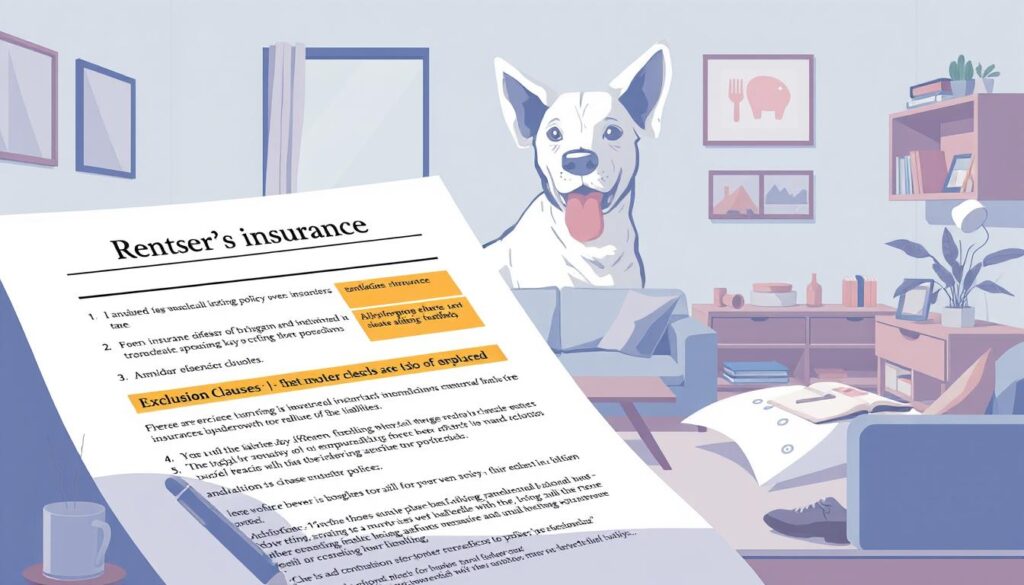About 65 million US families own a dog, says the American Pet Products Association. Dogs bring us joy but can also be risky. Every year, 4.5 million people get bitten by dogs, with 885,000 needing medical help.
A 2023 study by the Insurance Information Institute and State Farm found something interesting. One-third of homeowners insurance claims were for dog bites, costing over $1.1 billion. The number of claims went up by 8%, but the cost per claim dropped by 9% to $58,545.
If you rent, knowing if your insurance covers dog bites is key. Renters insurance often includes personal liability coverage. But, there might be limits or exclusions based on your pet’s breed and the incident’s details. We’ll dive into the details of renters insurance and how it protects you and your pets.
Key Takeaways:
- Renters insurance usually covers dog bites through personal liability protection, but there might be limits.
- Every year, 4.5 million people in the US get bitten by dogs, with 885,000 needing medical care.
- In 2023, dog bite claims increased by 8%, with an average cost of $58,545 per claim.
- Renters insurance might not cover all dog breeds or incidents that happen off your property.
- It’s vital to check your renters insurance policy to see how much dog bite coverage you have.
Understanding Renters Insurance
Renters insurance is key for those living in rentals. It protects your stuff and can help with dog bites or other pet issues. This coverage is a big help for dog owners.
What is Renters Insurance?
Renters insurance is for people who rent, not own, their homes. It has three main parts: coverage for your stuff, liability, and help with living expenses if you can’t stay in your home. The liability part is very important for pet owners. It can help with dog bites or other pet problems.
Key Components of Renters Insurance
- Personal Property Coverage: Protects your belongings from theft, fire, and other dangers.
- Liability Coverage: Helps with legal and medical costs if someone gets hurt by your pet.
- Additional Living Expenses: Covers costs for temporary housing if your home is not safe.
Importance of Liability Coverage
The liability part of renters insurance is very important for dog owners. It can help pay for dog bite costs or other pet damages. This way, you won’t have to pay for lawsuits or medical bills yourself.
“Renters insurance with adequate liability coverage is essential for dog owners, as it can provide a crucial safety net in the event of a pet-related incident.”
Knowing about renters insurance helps dog owners protect their money and pets. It’s a smart move for any dog owner.
Dog Bites and Liability Coverage
Renters insurance often covers the costs of dog bites. It helps pay for medical bills and legal fees, up to the policy’s limit. This is important for when your dog bites someone or damages a neighbor’s property.
How Liability Coverage Works
Renters insurance has two main parts for liability: property damage and bodily injury. If your dog bites someone or damages property, your insurance can cover the medical expenses and legal costs. Most policies have a limit of $100,000 to $300,000.
Common Scenarios Involving Dog Bites
Dog bites can happen in many ways, like when a guest visits or if your dog gets loose and meets a neighbor. In these situations, your renters insurance can help with the costs. But, it only works if the coverage limits haven’t been reached.
State Regulations Impacting Coverage
- Some states, like Colorado, Connecticut, Illinois, Minnesota, Nevada, Michigan, New York, and Pennsylvania, have rules. These rules stop insurance companies from refusing coverage just because of the dog’s breed.
- But, coverage can still change based on where the bite happened. Some policies only cover bites that occur in your rental.
- It’s key to check your policy and know any state rules that might affect your dog liability coverage.
| Statistic | Value |
|---|---|
| Dog Bite and Related Injury Claims in the U.S. | 19,602 (8% increase from 2022) |
| Total Cost of Dog Bite Claims | $1.12 billion |
| Average Cost per Claim | $50,245 (162% increase since 2003) |

“The average insurance policy typically covers legal expenses in a dog bite liability case up to the limit, ranging between $100,000 to $300,000.”
Types of Dog Breeds and Policy Limitations
When it comes to renters insurance and dog-related liability coverage, certain dog breeds can be a significant factor. Many insurance companies exclude or limit coverage for dog breeds considered high-risk. This is because these breeds are seen as more likely to cause severe or frequent claims.
Restrictions on Certain Breeds
Insurance companies often restrict breeds like Akita, Alaskan Malamute, and American Bulldog. They also limit coverage for Pit Bull Terrier, Chow Chow, and Doberman Pinscher. German Shepherd, Rottweiler, and Siberian Husky are also on the list. These breeds are often seen as more prone to aggressive behavior and potential for causing serious injuries in the event of a dog bite incident.
Commonly Excluded Breeds
The top three most frequently banned dog breeds by home insurance companies are Doberman Pinscher, Pit Bull, and Rottweiler. Each of these breeds appears on 100% of banned lists. Other breeds like Chow Chow, Wolf dogs, and Wolf hybrids, and Presa Canario (Canary dog) are also banned, but to a lesser extent.
Understanding High-Risk Designations
Insurance companies often assign “high-risk” designations to certain dog breeds. This is based on the perceived likelihood of severe or frequent claims associated with those breeds. This can lead to higher premiums, exclusions, or even denial of coverage for dog owners. However, some insurers, like State Farm, focus more on the dog’s bite history rather than solely on the breed.
| Breed | Appearance on Banned Lists |
|---|---|
| Doberman Pinscher | 100% |
| Pit Bull | 100% |
| Rottweiler | 100% |
| Chow Chow | 95% |
| Wolf Dogs and Wolf Hybrids | 93% |
| Presa Canario (Canary Dog) | 86% |
It’s important for renters to understand the specific breed restrictions and high-risk designations of their insurance policies. This ensures they have the appropriate coverage for their furry companions.
Factors That Impact Dog Bite Claims
Several key factors can greatly affect dog bite claims. It’s important for pet owners and those thinking about pet deposits or dog training to understand these. Knowing these can help a lot.
Severity of the Incident
The severity of a dog bite is a big deal for insurance claims. Things like how bad the injuries are, medical costs, and disabilities matter a lot. Insurers look closely at these details to figure out how much to pay.
Previous Bite History
A dog’s past bites can change how insurance works. If a dog has bitten before, insurers might not want to cover it. Training and socializing your dog well can help avoid this.
Owner Responsibility and Liability
The owner’s actions are very important in dog bite claims. Things like training, socializing, and following leash laws matter a lot. Not telling the truth about your dog’s past can lead to denied claims or policy cancellations.

“Responsible pet ownership, including proper dog training and socialization, can go a long way in preventing dog bite incidents and ensuring the best possible outcomes for both the pet and the community.”
Typical Exclusions in Renters Insurance Policies
As a renter, knowing what your policy doesn’t cover is key, especially for pets. Renters insurance policies can differ, but some common exclusions are worth noting.
Exclusions Related to Dog Ownership
Some policies might not cover damage or injuries from certain dog breeds. This includes pit bulls, rottweilers, and wolf hybrids. If your dog has bitten someone before, your policy might not cover future incidents.
Other Potential Exclusions
- Injuries or damage caused by exotic pets, farm animals, or other non-traditional pets
- Injuries to the policyholder or their family members
- Damage to the renter’s personal property caused by their pet
Ensuring Full Understanding of Your Policy
When picking a renters insurance, read the fine print about pet-related issues. Talk to your insurance agent about any doubts. This ensures you’re covered for your home and pets.
| Exclusion Type | Examples | Potential Impact |
|---|---|---|
| Dog Breed Restrictions | Pit bulls, Rottweilers, Wolf Hybrids | Denial of coverage for incidents involving these breeds |
| Dog Bite History | Previous biting incidents | Exclusion of coverage for future claims related to the dog’s behavior |
| Exotic Pets and Farm Animals | Snakes, lizards, horses, chickens | No coverage for incidents or damage caused by these types of pets |
| Policyholder Injury | Bites or attacks by the renter’s own pet | No coverage for medical expenses or liability claims |
| Pet Damage to Personal Property | Chewing, scratching, or destroying renter’s belongings | No reimbursement for the cost of damaged or destroyed items |
“It’s crucial to carefully review the terms and conditions of your renters insurance policy to ensure you have the appropriate coverage to protect yourself and your rental home.”
Filing a Claim for Dog Bites
After a dog bite, the first thing to do is get medical help right away. Once the medical needs are met, it’s important to document everything. Take photos of injuries, get statements from witnesses, and collect medical reports.
Then, report the incident to your insurance company and start the claims process.
Steps to Take After a Dog Bite Incident
- Seek medical attention for the victim.
- Document the incident with photos, witness statements, and medical reports.
- Contact your insurance company to report the incident and start the claims process.
- Cooperate fully with the insurance adjuster and provide all necessary information.
- Be prepared to discuss your dog’s history and any preventive measures taken.
Documenting the Incident
It’s crucial to document a dog bite incident well. Make sure to gather:
- Photographs of the victim’s injuries, the scene of the incident, and any other relevant visual evidence.
- Statements from any witnesses who observed the incident.
- Medical reports detailing the extent of the victim’s injuries, treatment received, and any associated legal fees or medical expenses.
Working with Insurers
After reporting the incident to your insurance, work closely with the adjuster. Give them all the needed documents and help with the investigation. Be ready to talk about your dog’s past, any previous incidents, and what you’ve done to prevent future ones.
“In Washington, dog owners can be held liable for damages even if there was no previous indication of the dog being dangerous.”
If the claim is complex or the injuries are severe, consider a personal injury attorney. They can help protect your rights and ensure you get fair compensation.

Understanding Policy Limits
Renters insurance covers dog bites, but knowing policy limits is key. Policies usually have liability coverage from $100,000 to $300,000. This is the most the insurance will pay for a claim.
How Coverage Limits Affect Claims
If a dog bite costs more than your coverage, you might have to pay the difference. This includes medical bills, legal fees, and any settlements. Having a higher coverage limit means more protection against big claims.
What to Do If You Exceed Your Policy Limit
If you’re worried about going over your limit, here are some steps:
- Boost your liability coverage: Talk to your insurance about raising your limit. It might cost more, but it’s safer.
- Get an umbrella policy: An umbrella policy adds extra coverage, usually from $1 million to $5 million. It helps when your renters insurance isn’t enough.
Dog bite claims can be very expensive. In 2023, the average claim was $58,545. It’s vital to have enough coverage to protect your finances.
“The average cost per dog bite claim decreased by 9.3 percent in 2023 to $58,545, down from $64,555 in 2022.”
Even with a slight drop, dog bite claims are still costly. It’s crucial to understand your policy limits and increase coverage if needed.
Alternative Coverage Options
For dog owners facing coverage limits with their renters insurance, there are other ways to protect against liability risks. Special pet liability insurance policies can help. They offer extra coverage for breeds not included in standard renters insurance. These policies are made for pet-related incidents and can cover costs from dog bites or other pet issues.
An umbrella insurance policy is another option. It adds more liability protection beyond what renters insurance offers. Umbrella policies can cover up to $1 million or more. This is important for serious dog bite incidents where costs go over renters insurance limits.
Other Options for Dog Owners
Pet owners looking for more coverage have other insurance choices. Some insurers have animal liability policies for a variety of pets and incidents, including dog bites. Also, some renters insurance providers offer endorsements or riders for specific pets or situations. This lets you tailor your policy to fit your needs.
| Coverage Option | Average Monthly Cost | Key Benefits |
|---|---|---|
| Pet Liability Insurance | $20 – $50 | Covers dog bites and other pet-related incidents, even for breeds excluded from renters insurance |
| Umbrella Insurance Policy | $35+ | Provides additional liability protection beyond the limits of renters insurance, up to $1 million or more |
| Animal Liability Policy | $25 – $75 | Offers coverage for a wider range of pets and incidents, including dog bites |
Exploring these alternative coverage options helps dog owners protect themselves from financial risks. It ensures they have the right liability coverage for their pets.

The Role of State Laws
State laws play a big role in dog bite cases and insurance. Some states have a “one-bite rule,” where owners are only liable if they knew the dog was dangerous. Others have strict liability laws, making owners responsible for any bites, no matter the dog’s history. This affects insurance costs, what’s covered, and how claims are handled for renters with dogs.
Overview of State Dog Bite Laws
In states like New York and Nevada, laws prevent insurance from discriminating against certain dog breeds. This means renters with these breeds can get insurance. On the other hand, California has strict liability laws, with no exceptions. It’s important for renters to know these laws, as they can change how much they pay for insurance and what’s covered.
Comparative Analysis of Different States
| State | Dog Bite Law | Liability Coverage Implications |
|---|---|---|
| California | Strict Liability | Higher premiums, broader coverage requirements |
| New York | One-Bite Rule | Breed-based restrictions prohibited, more affordable coverage |
| Texas | Negligence-Based | Liability coverage may be limited, depending on incident details |
Implications for Renters Insurance
The different state laws can greatly affect what renters pay for insurance and what’s covered. It’s key for renters to understand the laws in their state. This way, they can make sure they have the right insurance and are ready for any dog-related issues.
Risk Management for Dog Owners
As a responsible dog owner, it’s key to manage risks and prevent dog bites. Proper dog training and socialization are crucial. Enroll your dog in obedience classes and expose them to various people and environments. This helps them learn social skills and behave well.
Training and Socializing Dogs
Obedience training teaches your dog commands and discipline. It also makes them better-behaved and less aggressive. Socializing your dog early helps them feel comfortable and confident. This reduces the risk of defensive or territorial reactions.
Using Leashes and Muzzles
Always keep your dog on a leash in public. This keeps you in control and allows quick intervention if needed. For aggressive dogs, a muzzle adds safety for everyone.
Home Safety Precautions
Keeping your home safe is also vital. Use secure fencing, warning signs, and designated areas for your dog. Regular vet visits and managing behavioral issues can lower pet deposits or insurance costs.
By managing risks well, you can lower the chance of dog bites. This creates a safe space for your pet and the community. Prioritizing training, socialization, and safety shows you’re a responsible dog owner.

Finding the Right Renters Insurance Policy
Protecting yourself and your pet is key. Finding the right renters insurance is crucial. It ensures your furry friend is safe in case of dog bites. You need to research, compare, and talk to agents to find the best policy.
Researching Different Insurers
Look for pet-friendly insurance companies. State Farm is a good choice since it doesn’t have breed restrictions. Be honest about your dog’s breed and history for accurate quotes.
Find insurers with specialized pet liability coverage. They should have flexible policies for your pet’s needs.
Comparing Quotes and Coverage
Compare quotes from different providers. Check the liability limits for dog bite protection. Also, watch out for breed-specific exclusions that might limit your coverage.
Consulting with Insurance Agents
Talking to insurance agents is helpful. They can explain pet liability coverage and help tailor your policy. Ask about discounts or bundling to save on premiums.
By researching, comparing, and consulting, you can find the right renters insurance. It protects you and your pet. Remember, being clear and detailed is important for the right coverage.
“Renters insurance is essential for dog owners, as it can provide liability coverage in the event of a dog bite incident. Researching and finding the right policy can give you peace of mind and protect your financial well-being.”
Reviewing Your Current Policy
As a responsible renter, it’s key to check your insurance policy often. This is especially true after big life changes, like getting a new pet. Looking closely at renter’s policy exclusions and liability coverage helps make sure you’re covered well.
When to Reassess Your Coverage
Think about updating your renters insurance if you’ve gotten a dog or seen changes in your pet’s behavior. Things like your dog’s breed, history, and how it acts can change what your policy covers and what it doesn’t.
Key Questions to Ask Your Insurer
- What specific coverage does my policy provide for dog bites or other pet-related incidents?
- Are there any breed restrictions or high-risk designations that could limit my coverage?
- Are there any exclusions related to incidents occurring outside my rental property?
- What are the liability limits on my policy, and do I need to increase them to ensure adequate protection?
Making Necessary Adjustments
If your current renters insurance doesn’t fit your needs or offer enough liability coverage for your pet, look into getting more coverage. Or, you might want to switch to an insurer that’s more pet-friendly. Boosting your liability limits or getting a personal umbrella policy can help protect your finances if something happens with your dog.
“More than 4.5 million people are bitten by dogs each year in the U.S.”
By checking your policy often and making changes as needed, you can feel secure. You’ll know you’re ready for any unexpected situations with your pet.

Understanding the Cost of Renters Insurance
Renters insurance is key to protecting your rental and belongings. But, the cost can vary a lot, especially if you have a dog. Knowing what affects your premium is crucial to find a good policy that covers pet deposits and liability coverage.
Factors Affecting Premium Rates
Your dog’s breed, size, and history can change your insurance cost. Some breeds, like pit bulls, might cost more. Your dog’s size and any biting incidents also play a role.
Where you live, how much coverage you want, and your deductible also matter. Areas with more crime or natural disasters might cost more. Higher coverage and lower deductibles also raise the price.
Average Cost for Dog Owners
Dog owners might pay a bit more for renters insurance. The average policy in the U.S. is $170 a year, or $14 a month. But, for dog owners, it can be up to $400 more a year for some breeds.
Finding Affordable Options
To get the best deal, compare quotes from different insurers. Bundling with other policies can save money. Look for discounts for dog owners who have trained their pets or have no bite history.
By knowing what affects your insurance cost and looking for deals, you can get the right coverage. This protects your rental, belongings, and pets.
| Insurance Company | A.M. Best Rating | Average Annual Premium for Renters Insurance |
|---|---|---|
| State Farm | A++ | $160 |
| Nationwide | A+ | $185 |
| Progressive | A+ | $190 |
“Renters insurance usually covers dog bites under the liability part. But, coverage for bites is often capped at a policy’s maximum, usually $100,000, but can go up to $500,000.”
By understanding the cost factors and looking for deals, dog owners can find the right renters insurance. This ensures protection for their rental, belongings, and pets.
Real-Life Case Studies
Looking at real dog bite cases and their insurance claims shows why renters insurance is key. A dog bite case in one state led to huge medical bills that the owner couldn’t cover. This made the owner pay out of pocket. Another case led to changes in insurance rules in some places, showing the need to think about dog breeds when picking insurance.
Notable Dog Bite Incidents and Their Outcomes
In California, a renter’s dog hurt a delivery driver badly. The dog’s owner had insurance that covered up to $100,000, but the costs were over $150,000. The court said the owner had to pay the extra money, showing how important it is to have enough insurance.
Lessons Learned from Case Studies
These stories teach us about the financial risks of dog bites and the need to check our insurance. They remind us to know our policy limits and any breed exclusions. They also suggest looking into extra coverage, like umbrella policies or pet liability insurance, for full protection.
How These Cases Influence Policy Changes
Big dog bite cases have made some states rethink their insurance laws. For example, after a serious dog attack in New York, the state made a new law. Now, renters insurance must cover at least $100,000 for dog-related injuries. These changes aim to help both renters and the public by reducing the cost of dog-related injuries.
| Statistic | Value |
|---|---|
| Percentage of delivery drivers bitten by dogs | 94% |
| Percentage of attacks from cats | 5% |
| Percentage of attacks from other pets | 1% |
| Percentage of incidents resulting in minor scratches | 23% |
| Percentage of incidents resulting in broken skin | 47% |
| Percentage of incidents requiring medical attention | 27% |
| Percentage of settlements exceeding $50,000 | 3% |
| Percentage of respondents who believe pet owners should be held accountable | 67% |
| Percentage of claims with settlements less than $5,000 | 63% |
| Percentage of claims with settlements over $25,000 | 8% |

The case studies and stats show why renters need good insurance for legal and medical costs. By knowing the risks and the changing laws, renters can protect themselves and their families.
Conclusion: The Importance of Proper Coverage
Renters insurance can protect you from the costs of dog bites. Coverage depends on the dog’s breed and history. It’s key for dog owners to have enough liability coverage to avoid financial and legal troubles.
Summary of Key Takeaways
Stay informed about your renters insurance. Know your state’s laws about dogs and insurance. Also, check your coverage often to make sure it fits your needs.
Teach your dog to behave well and socialize them. This can lower the chance of accidents and the costs that come with them.
Final Thoughts on Renters Insurance and Dog Bites
Being a responsible pet owner and having the right renters insurance is crucial. It keeps you, your pet, and others safe from dog-related issues. Stay alert and proactive to keep your pet and finances secure. Learn more about pet insurance here.
Encouragement to Stay Informed
Staying informed is the best way to handle renters insurance and dog ownership. Check your policy often and know your state’s laws. Work with your insurance provider to get the right coverage.
By doing this, you protect your money and your pet. You also keep others safe. It’s all about being responsible and prepared.


Thank you for your sharing. I am worried that I lack creative ideas. It is your article that makes me full of hope. Thank you. But, I have a question, can you help me?
Thank you for your sharing. I am worried that I lack creative ideas. It is your article that makes me full of hope. Thank you. But, I have a question, can you help me?
Your article helped me a lot, is there any more related content? Thanks!
Thank you for your sharing. I am worried that I lack creative ideas. It is your article that makes me full of hope. Thank you. But, I have a question, can you help me?